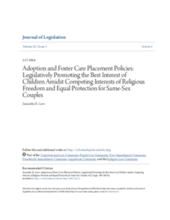Displaying 391 - 400 of 653
This study examines the link between Rejection Sensitivity (RS), Attachment Pattern (AP) and Socio-Emotional Adjustment (SA & EA) among adolescent's living in orphanages and those living with their parents. Adolescents (N=360) ranging between 14–18 years completed self-report measures. The findings suggest that there exists significantly positive and negative correlation as well as significant interaction between gender and living conditions among the variables RS, AP, SA and EA.
This country care review includes the care-related Concluding Observations adopted by the Committee on the Rights of the Child.
This paper analyzes the concluding sections of assessment reports on applicants for intercountry adoption in Sweden to answer the following question: what must be said about an individual or a couple in order for her/them to be seen as a suitable adoptive parent?
The purpose of this research is to provide an initial validation of a revision of the Transracial Adoption Parenting Scale—Revised (TAPS-R) with international transracial adoptive parents.
Establishing the context of this study of adoptive parenthood and open adoption, MacDonald describes the legal, policy, and social frameworks that shape the experience of adoptive parenthood. The role of adoption in child welfare policy is identified, specifically in the UK and USA where it provides permanence for significant numbers of children in State care.
The present study focused on whether parenting and family factors explain variance in cognitive and linguistic catch-up in children adopted internationally.
This study investigated the widely-used but under-researched program for training resource parents (i.e., foster, adoptive, or kinship parents) known as preservice PRIDE (Parent Resources for Information, Development and Education). The sample consisted of 174 participants in Ontario, Canada.
This report provides preliminary estimates of U.S. Adoption and Foster Care Analysis and Reporting System (AFCARS) data for Fiscal Year 2015.
The purpose of this article is to provide psychologists and adoption researchers with a conceptual model for the psychosocial adjustment of foster care adoptees with a background of maltreatment.
This article examines adoption and foster care placement policies as they pertain to the competing interests of religious freedom and equal protection for same-sex couples.



